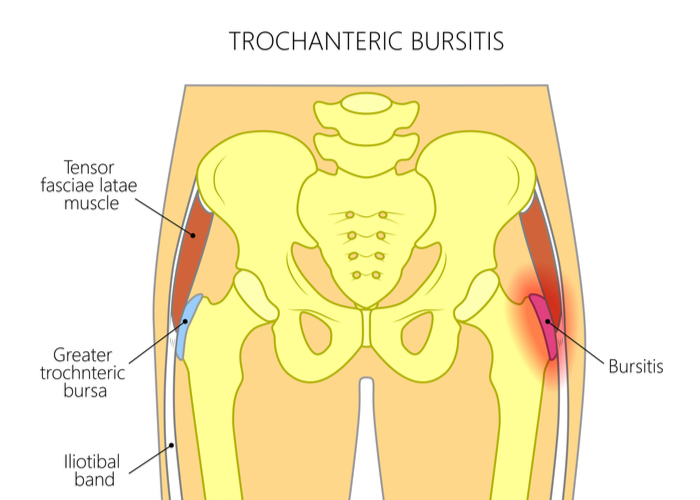What is trochanteric bursitis?
Throughout the joints of the human body are fluid-filled sacs known as bursae. These sacs are important joint structures for preventing inflammation by minimizing the friction between the tissues that occurs with joint movement. The hip joint, formed by the coupling of the head of the femur (thigh bone) and socket of the acetabulum (pelvis), has two major bursae: one along the inside of the hip near the groin and another covering the greater trochanter of the femur. The greater trochanter is found on the outer portion of the femur and is a bony prominence that is the attachment site for most of the major hip muscles. In addition to preventing inflammation, the trochanteric bursa also provides lubrication for the iliotibial (IT) band to painlessly glide past the greater trochanter. However, these fluid-filled sacs can become inflamed resulting in trochanteric bursitis. Physical active older individuals and younger athletes are commonly affected by this condition. Dr. Ronak Mukesh Patel, orthopedic hip specialist serving patients in Sugar Land, Pearland, and the Houston, Texas area, has the knowledge and understanding as well as substantial experience in treating patients who have experienced trochanteric bursitis.

What causes the bursae to become inflamed?
Hip pain with joint movement is often a consequence of the trochanteric bursa becoming irritated and inflamed. In fact, trochanteric bursitis is the most common cause of hip pain. Studies have found some particular characteristics that can make an individual more vulnerable to developing trochanteric bursitis, including:
- Hip Injury: The bursae can fill with blood causing inflammation of the lining in the event of a blunt force trauma directly to the hip.
- Gender and Age: Women are more affected by this condition than men and it is more prominent in patients between 40 and 60 years of age.
- Chronic Hip Pressure: Individuals who run, walk, bike, or stand for extended periods of time increase the likelihood of developing trochanteric bursitis.
- Gout: The accumulation of urate crystals in the synovial joints can lead to this painful condition.
- Abductor (gluteus medius) tendon tear: An underlying tendon tear can also lead to trochanteric bursitis as a symptom.
What are the symptoms of trochanteric bursitis?
A common complaint of trochanteric bursitis is hip pain directly over the greater trochanter of the femur. Some other common symptoms of trochanteric bursitis can include:
- Pain that radiates down the hip to the outer thigh
- Swelling of the affected extremity
- Limping or an abnormal gait
- Stiffness and difficulty walking after prolonged sitting
- Worsening pain at night, especially when lying on the affected side
- Dull ache located outside of the hip joint
How is trochanteric bursitis diagnosed?
A comprehensive medical history will be obtained by Dr. Patel to include any hip injuries or other hip conditions. This interview is followed by a thorough physical examination evaluating the hip for swelling, tenderness, and iliotibial (IT) band tightness. Diagnostic imaging studies, such as x-rays and magnetic resonance imaging (MRI), are useful for identifying any damage to the other hip joint structures. Another measure for confirming trochanteric bursitis is administering a local anesthetic directly into the trochanteric bursa. If the pain decreased or completely resolves is a positive indicator for trochanteric bursitis.
What is the treatment for trochanteric bursitis?
Non-surgical treatment:
Non-surgical therapies alone generally work well for the majority of patients with trochanteric bursitis. Rest and reducing physical activity for a period of time are strongly encouraged for younger, active patients. Ice application in addition to non-steroidal anti-inflammatory medications (NSAIDs) can be useful for controlling inflammation and pain. If the pain still persists with oral medications, a corticosteroid or platelet-rich plasma (PRP) injection directly into the trochanteric bursa can be administered. Participation in a physical rehabilitation program focused on strengthening and stretching is highly recommended. When these non-surgical treatment measures are carefully followed, symptoms of trochanteric bursitis should begin to subside within 4 to 6 weeks.
Surgical treatment:
Surgical treatment is often necessary for individuals with more severe trochanteric bursitis symptoms or when they did not respond well to non-surgical therapies. A surgery, called a trochanteric bursectomy, involves a small incision over the side of the hip and is typically performed to excise and remove the damaged portions of the trochanteric bursa. Any other irregularities contributing to trochanteric bursitis symptoms including abductor (gluteus medius) tendon tears are also addressed at this time.
Trochanteric Bursitis Specialist

Do you experience hip pain with motion, or pain that radiates down the hip to the outer thigh? If so, you may have a hip condition called trochanteric bursitis, or hip bursitis. Trochanteric bursitis occurs when the bursa in the hip becomes inflamed and is often seen in older individuals and younger athletes who are active in exercises such as running, walking or biking. Hip bursitis specialist, Doctor Ronak Mukesh Patel, provides diagnosis as well as surgical and nonsurgical treatment options for patients in Houston, Sugar Land, and Pearland, TX who are experiencing hip pain. Contact Dr. Patel’s team today!


